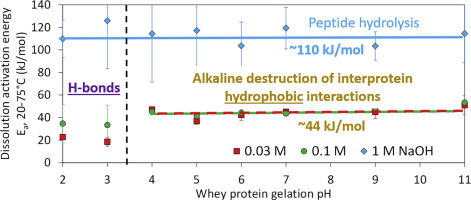当前位置:
X-MOL 学术
›
Food Hydrocoll.
›
论文详情
Our official English website, www.x-mol.net, welcomes your feedback! (Note: you will need to create a separate account there.)
The role of non-covalent interactions in the alkaline dissolution of heat-set whey protein hydrogels made at gelation pH 2–11
Food Hydrocolloids ( IF 10.7 ) Pub Date : 2019-04-01 , DOI: 10.1016/j.foodhyd.2018.10.035 Liyuan Fan , Anlei Ge , Xiao Dong Chen , Ruben Mercadé-Prieto
Food Hydrocolloids ( IF 10.7 ) Pub Date : 2019-04-01 , DOI: 10.1016/j.foodhyd.2018.10.035 Liyuan Fan , Anlei Ge , Xiao Dong Chen , Ruben Mercadé-Prieto

|
Abstract The alkaline dissolution of protein hydrogels occurs during the cleaning of protein-rich fouling deposits common in the food industry, as in the cleaning of whey protein deposits in dairy processing. Here we seek to identify which are the dissolution rate limiting mechanisms by systematically studying whey protein isolate (WPI) heat-set gels formed at different gelation pH between 2 and 11. Swelling, which facilitates mechanical erosion, is controlled by the gel microstructure (particulate or stranded), unlike chemical dissolution. Results show that the alkaline dissolution rate of WPI gels is mainly controlled by the breakdown reactions of interprotein non-covalent interactions, particularly hydrophobic ones at gelation pH 4–11, and by hydrogen bonds at pH 2–3. Furthermore, we propose that the very low dissolution rates at very high NaOH concentrations and low temperatures are not only caused by lack of swelling, but are due to the slowing down of these non-covalent breakdown reactions by the NaOH itself.
中文翻译:

非共价相互作用在凝胶化 pH 2-11 下制备的热固性乳清蛋白水凝胶碱性溶解中的作用
摘要 蛋白质水凝胶的碱性溶解发生在清洁食品工业中常见的富含蛋白质的污垢沉积物期间,如乳制品加工中乳清蛋白沉积物的清洁。在这里,我们试图通过系统地研究在 2 到 11 之间的不同凝胶化 pH 值下形成的乳清蛋白分离物 (WPI) 热固性凝胶来确定哪些是溶解速率限制机制。 促进机械侵蚀的溶胀受凝胶微观结构(颗粒或搁浅),不像化学溶解。结果表明,WPI凝胶的碱性溶解速率主要受蛋白质间非共价相互作用的分解反应控制,特别是凝胶化pH 4-11时的疏水性相互作用,以及pH 2-3时的氢键。此外,
更新日期:2019-04-01
中文翻译:

非共价相互作用在凝胶化 pH 2-11 下制备的热固性乳清蛋白水凝胶碱性溶解中的作用
摘要 蛋白质水凝胶的碱性溶解发生在清洁食品工业中常见的富含蛋白质的污垢沉积物期间,如乳制品加工中乳清蛋白沉积物的清洁。在这里,我们试图通过系统地研究在 2 到 11 之间的不同凝胶化 pH 值下形成的乳清蛋白分离物 (WPI) 热固性凝胶来确定哪些是溶解速率限制机制。 促进机械侵蚀的溶胀受凝胶微观结构(颗粒或搁浅),不像化学溶解。结果表明,WPI凝胶的碱性溶解速率主要受蛋白质间非共价相互作用的分解反应控制,特别是凝胶化pH 4-11时的疏水性相互作用,以及pH 2-3时的氢键。此外,



























 京公网安备 11010802027423号
京公网安备 11010802027423号